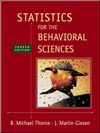 |  Statistics for the Behavioral Sciences, 4/e Michael Thorne,
Mississippi State University -- Mississippi State
Martin Giesen,
Mississippi State University -- Mississippi State
Probability
Chapter Overview| Probability theory is the key to testing statistical hypotheses. Statistical hypotheses are assumptions about
populations based on sample results. Probability theory enables us to determine the amount of certainty we
have in the conclusions we draw from our sample results.
The probability of an event is defined as the proportion of times an event would occur if the chances
for occurrence were infinite. Another way to say this is that the probability of an event is the ratio of the
number of ways the event can occur to the number of ways any event can occur. Although we constantly
assess probabilities in our daily lives, there are times when our intuitive ideas about probability are
incorrect. For example, the gambler’s fallacy is the mistaken belief that the probability of a particular event
changes with a long string of the same event. We often say that a team that has lost many times in a row is
due to win, as though the string of losses had changed the probability of the team’s winning.
To you as an individual, probability means probability, not certainty. Probabilities should be
considered patterns or tendencies, not guarantees about what will happen to you personally. Theoretical
probability, on the other hand, is the way events are supposed to work in terms of formal probability theory.
Real-world, or empirical, probability is based on experience, whereas subjective probability is our personal
probability, formed on the basis of our own perspective on the world. Bayesian statistics uses subjective
probability as a starting point for assessing a subsequent probability. The Bayesian approach to making
statistical inferences involves the use of these subjective, prior probabilities, which makes this approach
controversial.
The addition rule states that for independent events the probability of either one event or another is
equal to the sum of the probabilities of the individual events. The multiplication rule determines the
probability of a series of events. The multiplication rule states that the probability of two or more
independent events occurring on separate occasions is the product of their individual probabilities.
Conditional probability is the probability of an event given that another event has already occurred. The
multiplication rule can be modified to determine the probability of nonindependent events.
The binomial distribution—a simple theoretical probability distribution—is based on events for which
there are only two possible outcomes on each occurrence of the event. Coin-flipping examples are often
used to illustrate the construction of a binomial distribution. Two important features of the binomial are that
when p = .5, the distribution is symmetrical, and as the number of trials increases, the binomial more and
more closely approximates the normal probability distribution. |
|



 2003 McGraw-Hill Higher Education
2003 McGraw-Hill Higher Education